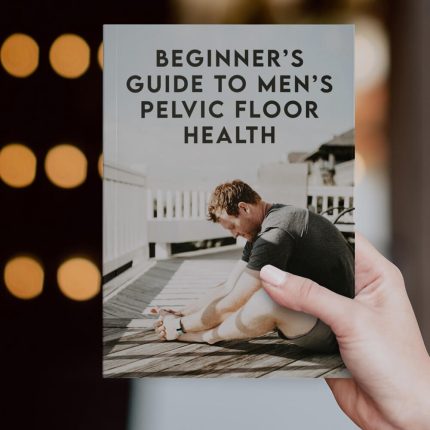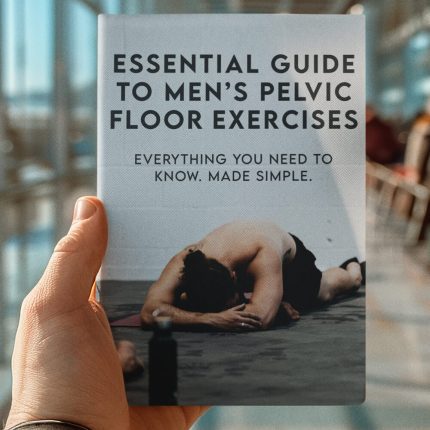
Pelvic Floor Therapy
Urinary Incontinence in Men

Ever felt like your pelvic floor is throwing a surprise party every time you laugh a little too hard or rush for the bus? Urinary incontinence in men is more common than you might think, and it’s time we break the taboo with a mix of straight talk, smart science, and a splash of humor. In this guide, we’re diving deep into everything from pelvic floor exercises to lifestyle tweaks that can help you reclaim control, boost confidence, and laugh in the face of bladder mishaps, all while keeping it real for our Gen-Z and millennial readers.
Quick Links to Useful Sections
- Understanding Urinary Incontinence in Men: The Basics You Haven't Heard of Yet
- The Hidden Impact on Daily Life (And Why You Shouldn’t Sweat It)
- Conventional Therapies: The Medical Lowdown
- Pelvic Floor Physical Therapy
- Medications and Medical Devices
- Pelvic Floor Exercises: The Secret Weapon to Take Control
- How to Master the Kegel
- Reverse Kegels: The Other Side of the Coin
- Integrative and Holistic Approaches: Beyond the Gym
- Acupuncture and Chiropractic Care
- Massage Therapy and Myofascial Release
- Herbal and Nutritional Supplements
- Mind-Body Practices: When Your Brain and Body Team Up
- Yoga and Pilates: Flexibility Meets Strength
- Meditation and Deep Breathing
- Nutrition and Lifestyle Tweaks: Fueling Your Healing Journey
- Anti-Inflammatory Foods to the Rescue
- Hydration and Lean Proteins
- Sleep and Stress Management: The Underestimated Duo
- Real Stories and Case Studies: The Proof Is in the Progress
- Case Study 1: From Awkward Leaks to Unstoppable Confidence
- Case Study 2: A Post-Surgery Comeback with a Holistic Edge
- Case Study 3: Breaking the Cycle of Stress and Incontinence
- Designing Your Personalized Urinary Incontinence Management Plan
- Step 1: Get a Professional Evaluation
- Step 2: Set Clear, Achievable Goals
- Step 3: Craft Your Integration Strategy
- Step 4: Implement a Consistent Routine
- Step 5: Monitor, Adjust, and Celebrate Progress
- Resources and Community Support: Your Next Steps
- FAQ: Your Questions on Urinary Incontinence in Men Answered
- Your Journey to Empowered Pelvic Health: Take the Leap
Understanding Urinary Incontinence in Men: The Basics You Haven't Heard of Yet
Urinary incontinence in men isn’t just an “old man” problem; it affects men of all ages, from athletes to busy professionals, and yes, even the coolest Gen-Zers. At its core, urinary incontinence is the loss of bladder control, which can range from occasional leaks when you sneeze to consistent challenges that impact daily life. But fear not; understanding the how and why is the first step to gaining back that control.
Medical experts explain that urinary incontinence often stems from issues with the pelvic floor muscles, which act like a supportive hammock for your bladder and other organs. When these muscles are weak or overdosed with tension, they can’t hold everything together as tightly as they should. Contributing factors might include aging, surgery, prostate issues, nerve damage, or even lifestyle choices. Regardless of the cause, the impact on your personal and professional life can be stress-inducing, especially in a world where nothing is off-limits for a good meme.
For many men, admitting to urinary incontinence can feel like sharing your deepest, darkest secret. But here’s the deal: you’re not alone. There’s a whole community out there finding innovative ways to manage the issue, blending high-tech solutions with natural, holistic practices. And the best part? With the right tools and know-how, you can kick those worries to the curb.
The Hidden Impact on Daily Life (And Why You Shouldn’t Sweat It)
Urinary incontinence might seem like a minor nuisance to some, but its impact is far more significant. Imagine being at a music festival or an important meeting when suddenly, your body starts sending you a not-so-subtle reminder that something’s off. Embarrassment, anxiety, and a constant preoccupation with finding the nearest restroom can take a toll on anyone’s mental health and social life.
Your pelvic floor affects how you move, how you use the bathroom, and how sex feels, yet most men are never taught how it works. This essential guide explains your pelvic floor in plain language and gives you a simple plan to relax, strengthen, and look after it at home.
Youll Learn How To:
- Understand what your pelvic floor does for bladder control, posture, and sex
- Spot signs of tension, weakness, and poor coordination
- Use breathing, reverse Kegels, and classic Kegels safely
- Improve habits for sitting, lifting, sport, sleep, and stress
Whats Inside: friendly explanations, safety guidelines, daily drills, sex function tools, flare up plans, and a complete twelve week program with trackers.
Perfect For: men of all ages who want less pelvic tension, fewer leaks, better comfort on the toilet, and more confidence in movement and in the bedroom.
But here's the silver lining: educating yourself about urinary incontinence in men opens up a world of management strategies that can reduce stress and enhance quality of life. And yes, that means there are plenty of ways to reclaim your day without having to plot a covert bathroom escape route at every social encounter.
It’s time to bust some myths. Urinary incontinence isn’t a sign of weakness or inevitable decline, it’s a manageable condition. By incorporating targeted pelvic floor exercises, lifestyle adjustments, and even some integrative therapies, you can create a robust, holistic plan to overcome those pesky leaks.
Conventional Therapies: The Medical Lowdown
Before we get into the body-hugging exercises and mindful practices, let’s set the stage with conventional treatments. These methods form the core of clinical management for urinary incontinence and offer a solid foundation from which to build a holistic regimen.
Medical professionals typically start with a comprehensive evaluation. This involves discussing your symptoms, diagnosing underlying issues with pelvic floor muscles, and sometimes even utilizing technologies like biofeedback to help pinpoint specific weak spots.
Pelvic Floor Physical Therapy
One of the go-to conventional treatments is pelvic floor physical therapy. Think of it like a gym session for your internal muscles. A skilled therapist will guide you through various exercises designed to strengthen the pelvic floor muscles, which are key to maintaining bladder control.
Manual techniques, such as myofascial release and trigger point therapy, are also common components of treatment plans. These therapies target the tension and adhesions that build up in your muscles, ultimately helping to alleviate pain and improve overall muscle function.
Medications and Medical Devices
Depending on the severity or underlying cause of your incontinence, medications like anticholinergics and beta-3 adrenergic agonists might be prescribed to reduce symptoms. In some cases, devices such as pessaries or even minimally invasive surgeries are considered, especially when other interventions haven’t done the trick.
While these options are backed by scientific evidence, team them with a proactive mindset and additional lifestyle modifications for a more robust defense against leaks.
Pelvic Floor Exercises: The Secret Weapon to Take Control
Let’s face it: when it comes to controlling urinary incontinence, the pelvic floor muscles are your MVPs. Pelvic floor exercises, popularly known as Kegels (yes, they’re as effective as they sound), are at the heart of strengthening these muscles. And no, you don’t need a gym membership, just a little time and determination.
The beauty of these exercises is their simplicity. Start by identifying the right muscles, which can be done by stopping your urine midstream (but don’t make it a habit in the restroom!). Once you’ve pinpointed them, it’s all about contracting and relaxing them in a controlled manner.
Your pelvic floor affects how you move, how you use the bathroom, and how sex feels, yet most men are never taught how it works. This essential guide explains your pelvic floor in plain language and gives you a simple plan to relax, strengthen, and look after it at home.
Youll Learn How To:
- Understand what your pelvic floor does for bladder control, posture, and sex
- Spot signs of tension, weakness, and poor coordination
- Use breathing, reverse Kegels, and classic Kegels safely
- Improve habits for sitting, lifting, sport, sleep, and stress
Whats Inside: friendly explanations, safety guidelines, daily drills, sex function tools, flare up plans, and a complete twelve week program with trackers.
Perfect For: men of all ages who want less pelvic tension, fewer leaks, better comfort on the toilet, and more confidence in movement and in the bedroom.
How to Master the Kegel
1. Find a quiet space where you can concentrate without distractions.
2. Contract your pelvic floor muscles for a count of three, then relax for a count of three. As you do this, breathe normally.
3. Aim for three sets of 10-15 repetitions per day and gradually increase the duration as your muscles get stronger.
It might feel a little awkward at first, like trying to coordinate dance moves you never learned, but stick with it. Over time, consistent practice can dramatically improve your bladder control and confidence. And hey, if your friends catch wind (pun intended) of your newfound commitment, you can always drop some savvy health tips at your next hangout.
Reverse Kegels: The Other Side of the Coin
While Kegels focus on tightening and strengthening the pelvic muscles, reverse Kegels emphasize relaxation. These exercises help release any tension that might be counterproductive to proper muscle function. Think of them as the cool-down session after an intense workout.
To perform a reverse Kegel, imagine you’re trying to gently push air out as if you’re letting go of a balloon. This movement encourages a controlled relaxation of the pelvic floor muscles. Integrating both Kegels and reverse Kegels into your routine creates a balanced approach, ensuring that you’re not only building strength but also maintaining muscle flexibility.
In short, these exercises are your best bet for a non-invasive, at-home treatment that can bring tangible improvements to urinary incontinence. So, gear up, get into a comfortable spot, and let those pelvic muscles do the heavy lifting!
EXPLORE OUR EXPERT MEN'S PELVIC FLOOR GUIDES WITH HIDDEN TIPS AND TRICKS
👨💻 Men's Pelvic Floor Book Store (Instant Download) 👨💻
Integrative and Holistic Approaches: Beyond the Gym
Sure, pelvic floor exercises are fantastic, but what if you could supercharge your healing by embracing a whole-body approach? Enter integrative and holistic therapies, a blend of conventional wisdom, modern medicine, and time-tested natural practices.
Think of this approach as crafting the ultimate multi-tasking routine where every aspect of your being, from your physical muscles to your emotional state, gets the attention it deserves. For urinary incontinence in men, this means combining the power of targeted exercises with stress reduction, nutritional tweaks, and even complementary therapies.
Acupuncture and Chiropractic Care
Many men are discovering that acupuncture can do more than just relieve stress and tension, it can also help reduce pelvic pain and improve bladder control. By applying fine needles at strategic points, acupuncture promotes better blood circulation and nerve function, which may indirectly boost pelvic floor performance.
Your pelvic floor affects how you move, how you use the bathroom, and how sex feels, yet most men are never taught how it works. This essential guide explains your pelvic floor in plain language and gives you a simple plan to relax, strengthen, and look after it at home.
Youll Learn How To:
- Understand what your pelvic floor does for bladder control, posture, and sex
- Spot signs of tension, weakness, and poor coordination
- Use breathing, reverse Kegels, and classic Kegels safely
- Improve habits for sitting, lifting, sport, sleep, and stress
Whats Inside: friendly explanations, safety guidelines, daily drills, sex function tools, flare up plans, and a complete twelve week program with trackers.
Perfect For: men of all ages who want less pelvic tension, fewer leaks, better comfort on the toilet, and more confidence in movement and in the bedroom.
Chiropractic care, particularly adjustments focused on the lower back and pelvis, can realign your body’s energy and minimize nerve interference. These treatments may relieve the tension that often leads to urinary incontinence, providing a natural complement to your pelvic floor exercises.
Massage Therapy and Myofascial Release
Ever had a back massage that left you feeling like you could dance the night away? Massage therapy isn’t just for relaxation, it can also help release stubborn muscle tension around the pelvic area. Techniques like myofascial release break down adhesions and knots, restoring fluidity to your muscle tissues, which is critical when tackling bladder control issues.
Herbal and Nutritional Supplements
What you put into your body is just as important as what you do with it. Certain herbs and supplements, including omega-3 fatty acids, turmeric, and antioxidants, can help reduce inflammation and promote muscle health. Of course, always check with a healthcare pro before starting any new supplement routine, but it’s clear that adding a dash of nature to your regimen can go a long way.
By blending these integrative practices with your standard pelvic floor exercises, you're not just treating a symptom, you’re cultivating overall wellness in a way that respects the complexity of your body. It’s about building a balanced routine that’s as flexible and dynamic as the modern man.
Mind-Body Practices: When Your Brain and Body Team Up
Let’s get one thing straight: no amount of physical exercise can completely counter the effects of stress and anxiety. The mind-body connection is a powerhouse when it comes to managing urinary incontinence. Practices like yoga, Pilates, and meditation not only calm the mind but also help regulate the body’s physical responses, meaning your pelvic floor muscles get a break from constant tension.
Yoga and Pilates: Flexibility Meets Strength
Yoga isn’t just about the poses; it’s about creating a space for your body to find balance. Specific yoga poses, think child’s pose, the cat-cow stretch, and even the bridge pose, can help relieve tension in the pelvic area while strengthening core muscles simultaneously. Pilates, on the other hand, zeroes in on the synergy between your core and pelvic floor, teaching you to move with precision and control. Both practices emphasize breath control, an essential factor in mitigating stress that can exacerbate incontinence.
Meditation and Deep Breathing
Ever tried to take a deep breath after a stressful day only to find yourself superficially sighing through the pain? Incorporating mindfulness and meditation into your daily routine can radically change the way your body responds to stress. Deep breathing exercises and meditation reinforce the natural rhythm between the diaphragm and the pelvic floor, creating an internal harmony that supports muscle relaxation and proper function.
Start with just five minutes a day by setting aside a quiet space, closing your eyes, and practicing diaphragmatic breathing. Over time, you’ll notice an improvement, not only in your overall mental clarity but also in the way your body handles pelvic tension.
Nutrition and Lifestyle Tweaks: Fueling Your Healing Journey
There’s no magic pill for urinary incontinence, but what you eat and how you live can make a world of difference. A nutrient-rich, balanced diet isn’t just about fitting into those skinny jeans; it’s about supplying your body with the building blocks it needs to repair and maintain your pelvic muscles.
Anti-Inflammatory Foods to the Rescue
Chronic inflammation can wreak havoc on your pelvic health. The remedy? An anti-inflammatory diet loaded with fruits, vegetables, lean proteins, and healthy fats. Fresh berries, leafy greens, and fatty fish like salmon can reduce inflammation, while whole grains and legumes offer long-lasting energy for muscle repair. It’s time to embrace colorful plates full of natural goodness.
Hydration and Lean Proteins
Keeping hydrated isn’t just for runners or gym buffs, urinary incontinence management thrives on proper hydration. Water helps maintain the elasticity of your muscles, ensuring the pelvic floor responds well during exercises. Additionally, lean proteins sourced from chicken, tofu, or legumes provide the necessary amino acids for effective muscle repair and strength building.
Sleep and Stress Management: The Underestimated Duo
We all know sleep is important, but it’s especially crucial when your body is in recovery mode. Aiming for a solid 7-9 hours each night can reduce overall stress levels and give your pelvic floor the downtime it needs to repair itself. Combine this with stress management techniques, whether it’s through meditation, a calming playlist, or a good old-fashioned walk in nature, and you have yourself a recipe for improved health and resilience.
When you pair these nutritional and lifestyle strategies with targeted physical therapies, you create an environment where healing isn’t just possible, it’s inevitable. The steps you take every day, from mindful eating to conscious movement, contribute to a healthier, more in-control you.
EXPLORE OUR EXPERT MEN'S PELVIC FLOOR GUIDES WITH HIDDEN TIPS AND TRICKS
👨💻 Men's Pelvic Floor Book Store (Instant Download) 👨💻
Real Stories and Case Studies: The Proof Is in the Progress
Sometimes the best motivation comes from hearing real-life experiences. Across the board, men from diverse backgrounds have embraced a holistic and integrative strategy to manage urinary incontinence, and the success stories are nothing short of inspiring.
Case Study 1: From Awkward Leaks to Unstoppable Confidence
Meet Alex, a 38-year-old graphic designer who once dreaded social outings because he feared a sudden leak might embarrass him in front of clients or during meet-ups. Alex began incorporating regular pelvic floor exercises into his routine, paired with mindfulness meditation and a revamped diet that focused on whole foods and hydration. Over the course of several months, Alex noticed fewer episodes of incontinence, improved bladder control, and a newfound sense of confidence that began reflecting in his art and social life.
Case Study 2: A Post-Surgery Comeback with a Holistic Edge
Michael, a 52-year-old fitness coach, underwent prostate surgery which left him with some unexpected urinary challenges. Determined to not let it derail his active lifestyle, Michael teamed up with a pelvic floor specialist and incorporated a blend of conventional therapy, biofeedback, and a steady stream of pelvic floor exercises into his daily regimen. Complementing this with gentle yoga and anti-inflammatory foods, Michael’s recovery not only got him back on track but also elevated his approach to overall well-being.
Case Study 3: Breaking the Cycle of Stress and Incontinence
David, a busy entrepreneur in his early 40s, realized that his high-stress lifestyle was taking a toll on his bladder control. With his body in constant fight-or-flight mode, his pelvic muscles were perpetually tense, leading to unwanted leaks. David’s breakthrough came when he adopted a holistic plan that mixed daily Kegels, structured mindfulness sessions, and nutritional strategies aimed at reducing systemic inflammation. As his stress levels decreased, so did the frequency of his incontinence episodes, proving that integrating mind-body techniques can be a total game-changer.
These real-life transformations underscore an important point: while urinary incontinence in men may seem like a fixed challenge, a personalized integrative approach can pave the way to improved function, less anxiety, and a return to living life on your own terms.
Designing Your Personalized Urinary Incontinence Management Plan
There isn’t a one-size-fits-all answer in the battle against urinary incontinence. Instead, the key is creating a plan that’s tailored to your unique body, lifestyle, and needs. Here’s a straightforward blueprint to get you started:
Step 1: Get a Professional Evaluation
Whether it’s through a pelvic floor specialist, a urologist, or your general healthcare provider, kick off your journey with a comprehensive evaluation. This assessment should cover your physical symptoms, lifestyle habits, and even your mental and emotional state.
Step 2: Set Clear, Achievable Goals
What do you want out of this journey? Whether it’s reducing occasional leaks during workouts or regaining complete control for worry-free social events, define your goals in measurable terms. Having a clear vision makes it easier to track progress, and trust us, every little win counts!
Step 3: Craft Your Integration Strategy
Mix and match the various approaches that resonate with you. This might include:
- Daily pelvic floor exercises (both Kegels and reverse Kegels).
- Mindfulness practices such as meditation or deep breathing sessions.
- Complementary therapies (acupuncture, massage, or chiropractic adjustments).
- A nutritional plan rich in anti-inflammatory foods and lean proteins.
- Tech-assisted methods like biofeedback to monitor progress.
Step 4: Implement a Consistent Routine
Consistency is the secret sauce. Build your routine around fixed times for exercise, meal planning, meditation, and adequate rest. Using digital calendars or habit-tracking apps can be a fun way to keep yourself accountable.
Step 5: Monitor, Adjust, and Celebrate Progress
Regular check-ins with your healthcare team and self-monitoring through a journal or app will help you keep an eye on what’s working, and what might need a little tweak. Celebrate every win, from longer intervals of dryness to an overall sense of well-being.
By taking these steps, you’re not just managing urinary incontinence; you’re rewriting the narrative around your health. Embrace this proactive approach, and soon you’ll notice that you’re in the driver’s seat of your own wellness journey.
Resources and Community Support: Your Next Steps
Knowledge is power, and sharing experiences is even more powerful. Surround yourself with supportive communities that understand the challenges and successes along the way. Consider joining online forums, social media groups, or local meet-ups dedicated to men’s pelvic health.
Many reputable organizations and specialists are out there to provide guidance, from medical advice to practical tips for integrating pelvic floor exercises into your everyday life. Explore webinars, podcasts, and workshops that focus on urinary incontinence and holistic pelvic health, and don’t hesitate to reach out for professional help if you need it.
Remember, every step you take is a building block to your ultimate goal of empowerment and quality of life. Stay informed, be proactive, and use the wealth of resources available to transform your journey from one of frustration to one of triumph.
FAQ: Your Questions on Urinary Incontinence in Men Answered
We've compiled some of the most frequently asked questions (FAQs) about urinary incontinence in men and pelvic floor health to help you navigate this condition with confidence.
1. What is urinary incontinence in men, and why does it happen?
Urinary incontinence in men is the involuntary leakage of urine, often caused by weak pelvic floor muscles, prostate issues, nerve damage, or other medical conditions. It can also be exacerbated by lifestyle factors and stress.
2. Are pelvic floor exercises (Kegels) effective for managing urinary incontinence?
Yes, pelvic floor exercises are one of the most effective non-invasive treatments. They strengthen the muscles that support bladder control, reducing leakage and improving overall pelvic stability.
3. Can urinary incontinence affect younger men?
Absolutely. While often associated with older men, urinary incontinence can affect younger men too. Factors such as athletic strain, stress, and lifestyle habits can contribute to the condition.
4. What is the role of integrative therapies like acupuncture in pelvic floor health?
Integrative therapies, including acupuncture, can help by promoting blood flow, reducing muscle tension, and supporting overall nerve function, all of which contribute to better pelvic floor control.
5. How can mindfulness and meditation help manage urinary incontinence?
Mindfulness and meditation reduce stress and anxiety, which can lower muscle tension in the pelvic area. They help you connect with your body, making it easier to perform targeted exercises effectively.
6. Are there any dietary recommendations to improve pelvic floor function?
Yes, an anti-inflammatory diet rich in fruits, vegetables, lean proteins, and healthy fats can support muscle repair and overall pelvic health. Adequate hydration is also key.
7. Can lifestyle modifications really make a difference in managing urinary incontinence?
Definitely. Combining pelvic floor exercises, nutritional tweaks, stress management, and integrative therapies creates a holistic approach that can lead to significant improvement.
8. How long does it typically take to see improvements with pelvic floor exercises?
Results vary per individual, but many experience noticeable improvements within a few weeks to a few months of consistent exercise and lifestyle modifications.
9. Is professional guidance necessary for managing urinary incontinence?
While many exercises and techniques can be safely performed at home, consulting a pelvic floor specialist or healthcare provider ensures that your plan is tailored to your specific needs.
10. How do biofeedback devices enhance pelvic floor training?
Biofeedback devices provide real-time feedback on muscle activity, helping you adjust your technique and confirm that you are engaging the correct muscles during exercises.
Your Journey to Empowered Pelvic Health: Take the Leap
Breaking free from the stigma of urinary incontinence is all about embracing a comprehensive, holistic route to recovery. With the right mix of pelvic floor exercises, integrative therapies, nutritional strategies, and lifestyle adjustments, you’re well on your way to regaining full control and living life unapologetically.
Every rep, every mindful breath, and every nutritious meal is a step toward a healthier, more confident you. Urinary incontinence may have been a surprise guest in your life for too long, but it doesn’t have to be the headline act. Instead, take charge with a personalized plan built on practical tips, real-life experiences, and scientific insight, crafted especially for our Gen-Z and millennial warriors.
Dive into the resources, connect with communities of like-minded individuals, and let each day’s progress be a reminder that you’re more than capable of mastering your pelvic health. Ready to turn the tables on urinary incontinence? Your journey to empowerment starts now, embrace it, celebrate every win, and remember: it’s not just about managing symptoms; it’s about reclaiming your freedom to live, laugh, and love without hesitation.
Your pelvic floor affects how you move, how you use the bathroom, and how sex feels, yet most men are never taught how it works. This essential guide explains your pelvic floor in plain language and gives you a simple plan to relax, strengthen, and look after it at home.
Youll Learn How To:
- Understand what your pelvic floor does for bladder control, posture, and sex
- Spot signs of tension, weakness, and poor coordination
- Use breathing, reverse Kegels, and classic Kegels safely
- Improve habits for sitting, lifting, sport, sleep, and stress
Whats Inside: friendly explanations, safety guidelines, daily drills, sex function tools, flare up plans, and a complete twelve week program with trackers.
Perfect For: men of all ages who want less pelvic tension, fewer leaks, better comfort on the toilet, and more confidence in movement and in the bedroom.
Curious About Your Pelvic Floor? Explore our curated collection of insightful articles to learn more and take charge of your health.
- Pelvic Floor Basics
- Pelvic Floor Exercises & Workouts
- Pelvic Floor Kegel Exercises: Techniques & Benefits
- Advanced Pelvic Floor Workouts
- Pre/Post-Natal Pelvic Floor Routines
- Pelvic Floor Exercises for Men
- Pelvic Floor Therapy Techniques
- At-home vs Professional Pelvic Floor Therapy Options
- Diet & Lifestyle for a Healthy Pelvic Floor
- Pelvic Floor Health & Wellness
- Specialized Pelvic Floor Conditions & Treatments
Now back to the main article!

















